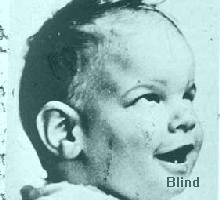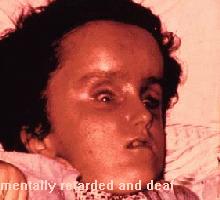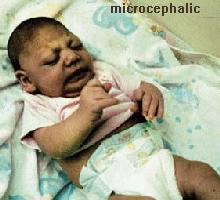

![]()
Being first cousins, the two families had been keen that they unite. A grand wedding with all the traditional trappings took place amidst echoes of happiness of both families.
 Joy
knew no bounds when Roshani announced the happy news that she was expecting her
first baby. As time passed and the day dawned, what greeted this young couple
was the birth of a physically deformed baby with an under-developed brain and
nerve functions. Garbed in a cloak of ignorance even then neither the couple
nor the family even attempted to seek advice.
Joy
knew no bounds when Roshani announced the happy news that she was expecting her
first baby. As time passed and the day dawned, what greeted this young couple
was the birth of a physically deformed baby with an under-developed brain and
nerve functions. Garbed in a cloak of ignorance even then neither the couple
nor the family even attempted to seek advice.
Consanguineous marriages - marriages between those who have common ancestors, have always been closely linked to Sri Lankan society and culture. Such marriages have never been taboo in our conservative Asian society, rather they were favoured and encouraged by families for reasons such as conservation of their wealth, preserving and upholding the social status and consolidating unity within the family or dynasty, and even for pure convenience.
Little or no thought was given to the risks involved, namely the increased risk of birth defects in children of such union.
That consanguineous marriages are still very much sought after and considered ideal is indeed a shocking revelation. It is this surprising fact that prompted the Human Genetics Unit of the Faculty of Medicine, University of Colombo, to launch a campaign to create public awareness and educate school children on the risks involved in such marriages.
According to the Head of the Unit, Prof. Rohan Jayasekara, on an average, at least three couples seek counselling and advice every week and the need to take the message to the public has never been more urgent.
Before long Roshani conceived again and the couple took extra care this time, but without success, tragedy struck a second time. This time the baby was apparently physically perfect but with complete hearing loss and totally blind. It was only after this nudge of volcanic proportions did Roshani and Gihan succumb to the suggestion that they seek advice on the matter.
The couple were in the prime of life, in perfect physical and mental health, with no defect or disorder affecting any of them or any other in their respective families. In desperation they visited Prof. Jayasekara, who, having analysed the features in the babies and their respective medical histories and pedigrees concluded that the birth defects were caused by the consanguineous marriage they had been misguided into. The couple, psychologically traumatised and stricken with guilt now gaze helplessly at the two suffering forms before them, blaming their parents for it all.
 The
circumstances in which advice and counselling are sought for consanguineous
marriages are diverse. According to Prof. Jayasekara, the most common form is a
proposal arranged by the families with the consent of the couple who are well
aware of the dangers ahead but unable to protest or disagree due to family
pressure.
The
circumstances in which advice and counselling are sought for consanguineous
marriages are diverse. According to Prof. Jayasekara, the most common form is a
proposal arranged by the families with the consent of the couple who are well
aware of the dangers ahead but unable to protest or disagree due to family
pressure.
The second most common category is where courting couples seek advice, but on receiving it and being fully aware of the risks, are still unable to part from each other due to the intimate nature of their relationships.
The last category come to accept their plight only after they conceive children with birth defects.
In the case of Ramani and Ranil they were introduced to each other by their parents. They fell in love at first sight but were first cousins. In their case the parents were ignorant of the risks they carried but the couple were well aware of them and the possible consequences of going through with it.
Nevertheless for the sake of peace and the fear of disrupting the unity between the two families they decided to go through with it. They, of course were lucky.
The first pregnancy was a success and then they sought counselling where they were advised to avoid any more pregnancies. Those were the few that were fortunate and got away Prof. Jayasekara said.
Many are puzzled as to what is meant by a blood marriage. It is a marriage between individuals who are the children of two brothers, two sisters, a brother and a sister, or a union between an uncle and his niece or an aunt and her nephew. Such marriages should be avoided as they carry double the risk of producing children with birth defects such as mental retardation, neurological problems, deafness and blindness when compared with an ‘unrelated’ marriage, says Prof. Jayasekara.
According to him many pregnancies that carry defective foetuses are either miscarried or aborted and some conditions caused by the union of blood relations do not even manifest at birth but become apparent later. Even certain medical conditions like diabetes, hypertension (high blood pressure) occur more frequently in the children if both families have this condition.
In addition there are quite a few commonly held false beliefs that circulate in society which contribute to unwarranted anxiety and bring about great disappointments. An example of the former is the belief that marriages between individuals who are firstborns in their respective families are not desirable.
An example of the latter is a marriage between individuals whose mothers are sisters and that such marriages do not increase the risk of birth defects, which is certainly not so.
All the features and functions of a baby are determined by information found in his or her genes. Genes are located in chromosomes which are found inside the nucleus of the cells in the body. Each cell has 46 such chromosomes where the baby inherits 23 from each parent. Humans have 4-8 bad genes which are also known as weak genes.
These can produce defective features only when a pair of bad genes exist, with a contribution of one gene from each parent. The chance meeting of a pair of identical bad genes is certainly much higher when the individuals have common grandparents as in first cousin unions, than if they were unrelated. However, if in a chromosome pair one gene is bad and the other normal, then the baby would be free of any defects.
In Sri Lanka the availability of counselling centres for such referrals are limited, and even so, the public awareness with regard to this problem needs to be strengthened.
Genetic counselling does provide those seeking information or advice a true picture of the situation with its associated risks.
 It
also assists and guides those seeking help with the necessary knowledge and
offers available facilities and options to cope with individual situations.
It
also assists and guides those seeking help with the necessary knowledge and
offers available facilities and options to cope with individual situations.
However in the case of difficult or complicated problems, never will the doctors force their decisions on the couple, bearing in mind the personal needs and beliefs of the individual, says Prof. Jayasekara.
When questioned as to what role the family unit plays in this programme, he emphasised the fact that a lack of a dialogue between parents and children does contribute in a very definitive manner. Firstly the parents need to be aware and this must most certainly be communicated to their children he said not only from the family unit but also from schools and even from religious institutions.
He further said, as a first step they have published and distributed an easily readable brochure explaining the hazards of blood marriages and explaining the mechanisms that contribute to it.
These have reached over 75 schools and other institutions in the island and at present are being distributed to offices and other places where adult awareness of the problem can be created.
The response has been excellent and they hope to carry the message to all regions of the country.
Prof. Jayasekera also emphasised that this programme is not new to society as Dr. Reggie Seimon the well known Opthalmologist in Kandy has been at the forefront of a similar campaign for a long time.
Though at present confined to only a part of the country, it is hoped that this campaign which carries a symbol of a shattered heart will get the message across and save many parents needless heartache and sorrow.
Return to the Plus contents page
![]()
| HOME PAGE | FRONT PAGE | EDITORIAL/OPINION | NEWS / COMMENT | BUSINESS
Please send your comments and suggestions on this web site to
info@suntimes.is.lk or to
webmaster@infolabs.is.lk